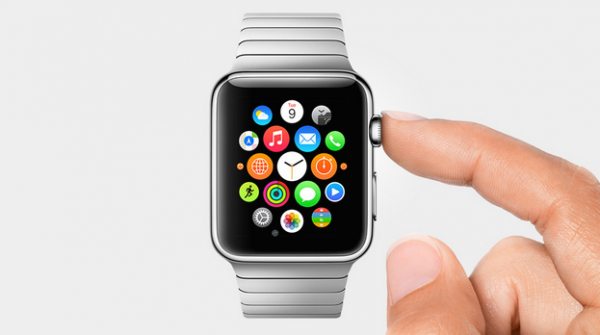Use Your Words - The Apple Watch and the Devolution of Language
A brief glimpse of our upcoming taptic terror.

At long last, a brand new Apple product category is almost here. In 2015, five years after rewriting the whole tablet rulebook with the iPad, Apple looks to do the same to wearable technology with the Apple Watch. However, while watching its debut during the most recent Apple press conference, I couldn’t help but notice a disturbing trend amidst all the talk of fitness integration, luxury gold bands, revolutionary payment systems, and elegant digital crowns: when it comes to how we actually communicate with each other, Apple Watch seems like a big step back.
Words. We’ve used them for millennia to grasp and distill the incalculable vastness of human ideas, knowledge, and experiences. We use them to know the unknowable and express the inexpressible, even if the prose is occasionally, intentionally, overwrought. Sure, some things defy description, but it would be hard to overestimate the role of language in advancing civilizations and the lives within them.
But the Apple Watch’s most touted communication features run counter to all of that, even when compared to the butchered text-speak that passes for words on mobile devices. Kids these days... So let’s start at the top and work our way down. You can use the Apple Watch to record and send voice messages, sort of like a walkie-talkie, as well as dictate to Siri. You can do that on an iPhone too, which you must own to use Apple Watch, but wrists are more immediate. Besides, at least this involves speaking like an actual person.
Apple Watch also lets users sculpt custom emojis by physically manipulating a 3D smiley face. Again, this isn’t too bad. It’s a fool’s errand to try and reduce the subtlety and complexity of human feelings and facial expressions, slight tics our species has evolved to be able to analyze and interpret, down to such a rough facsimile. But if anything, the customization provides more room for creativity and emotional accuracy than today’s rigid, unchanging emojis, not including imoij of course.
 However, the minute Vice President of Technology Kevin Lynch comes on stage to showcase the Apple Watch’s most “breakthrough” communication tools, things go downhill so laughably fast it’s almost like we can see the end of history on the horizon. First there’s the “Taptic Engine,” a force feedback mechanism that lightly taps the user’s wrist. In an alternate sci-fi universe, one could imagine spies using these to discreetly send each other Morse code messages. But in our world, it’s for recording and sharing heartbeats among friends. Because that’s what people in platonic relationships want, to just go about their days intimately “feeling” each other.
However, the minute Vice President of Technology Kevin Lynch comes on stage to showcase the Apple Watch’s most “breakthrough” communication tools, things go downhill so laughably fast it’s almost like we can see the end of history on the horizon. First there’s the “Taptic Engine,” a force feedback mechanism that lightly taps the user’s wrist. In an alternate sci-fi universe, one could imagine spies using these to discreetly send each other Morse code messages. But in our world, it’s for recording and sharing heartbeats among friends. Because that’s what people in platonic relationships want, to just go about their days intimately “feeling” each other.
Users can draw and send little pictures as well. To be fair, pictures are also a crucial, more ancient part of communication. They have their valuable place. However, when these powers combine, wrist-touching and picture-sharing, it’s like something out of Idiocracy. First, Lynch explains how he and a fellow Apple executive have devised their own new Apple Watch language system where a series of rapid taps means “I’m hungry, let’s get lunch.” When the executive sends a picture of a question mark representing “What should we eat?” Lynch responds with a crude drawing of a blue fish to signify “Sushi.” And then everyone claps. Just watch around an hour and 26 minutes in.

This is such a crazy, regressive, unnecessary, and unwanted reinvention of a scenario already happening just fine on phones throughout the world. All it takes is three texts: “Hey let’s get lunch!” “Okay what should we get?” “How about sushi?” But now, ironically enough, new technology has reduced two people clearly talking with words into two cyber-cavemen cobbling together an arcane system of arm-slapping and bad scribbles to desperately express their primal hunger.
So the Apple Watch, at least based on what we’ve seen so far, isn’t the big leap forward in communication we hoped it would be. In fact, it’s arguably the opposite. However, it’s not really its fault. The screen is just too small for effectively sending the straightforward text messages that could easily solve these problems. Therefore, the real question becomes why do we need a device so small in the first place? Well, it’s because our otherwise perfectly functional phones, for no reason at all, have simply become too huge to be the truly portable and accessible everyday devices we need them to be. So if you’re looking for the real culprit behind the insidious plot to replace our classic, beloved, intellectual, and humanizing words with dumb fish pics, don’t blame the Apple Watch. Blame big phones.